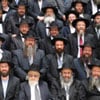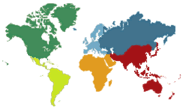Chabad-Lubavitch emissary Rabbi Dovid Yitzchok Hazdan, dean of the Torah Academy and rabbi of the Great Park Synagogue in Johannesburg, South Africa, will deliver the keynote address at the International Conference of Chabad-Lubavitch Emissaries (Kinus Hashluchim) gala banquet on Sunday, Nov. 27. The evening event, which is attended each year by more than 5,000 emissaries and guests, concludes four days of programs that begin on Thursday in the Crown Heights neighborhood of Brooklyn, N.Y.
The rabbi is also the initiator of an annual Lag BaOmer event in Johannesburg that attracts between 4,000 and 5,000 people a year from 50 different communities.
Hazdan and his wife, Feige, have served as emissaries of the Rebbe—Rabbi Menachem M. Schneerson, of righteous memory—since 1983. Three of their four children also serve as Chabad emissaries in South Africa; their youngest recently got married and is living in Crown Heights.
This year’s banquet will be held at a new venue, Brooklyn’s spacious Pier 8, directly across from Governors Island and overlooking the New York City skyline.
Q: You and your wife, Feige, have been living and working in South Africa since 1983. Where are you from originally, and how did your shlichus to South Africa come about?
A: I was born in a little town 100 miles from Johannesburg, where my father, Rabbi Yisroel Hazdan, served as rabbi and shochet (ritual kosher slaughterer). I completed school in Johannesburg before going to yeshivah in Kfar Chabad, Israel. My wife, Feige (nee Slavin) was born in Montreal and then lived in the Crown Heights neighborhood of Brooklyn, N.Y.

Q: What changes have you seen in the Johannesburg Jewish community over the years, particularly since 2000, and more specifically, in your immediate community?
A: There have been numerous changes in South Africa since I was a child. The country has changed politically, socially and economically. It went through a transformation to a new democratic South Africa.
Religiously, a spiritual awakening took place during the early 1970s. Chabad has played a major role in beginning and sustaining the growth in Torah and mitzvot here. South Africa has become a dynamo of Jewish resurgence that has affected Jewish life across the world. For example, the Shabbos Project originated in South Africa; it has been very successful and has been embraced by cities around the world.
In the past decade, the Torah Academy (the Chabad community school) has grown considerably, and now enrolls 600 students and continues to grow.
The Great Park Synagogue where I serve as rabbi opened the doors of a new campus in 2000. It relocated then from the inner city, where it was the mother congregation of Johannesburg, but had suffered from shifting demographics and was about to die. It has thrived in the new location (about five miles away), which still houses all the furnishings from the old shul. It is now a young community that is expanding.
A few years ago, we built a mikvah that now serves more than 100 families. A large proportion of them have only just begun to keep taharat Hamishpachah (Jewish laws of family purity) since it opened. We also began adult-education courses; programs for children, teens and young adults; a community center; and the Johannesburg Torah Institute for Shiurim.
The past 17 years have truly been exciting times.

Q: How did you initiate the annual Lag BaOmer event, which draws some 4,500 people a year? What were its beginnings, and when did it grow to become so large?
A: The Lag BaOmer event began slowly. Soon after the new campus was built, we initiated a unity event and invited a few shuls to join. A few hundred people attended. (I remember then that the generator was louder than the music it was providing electricity for.)
Each year, we asked additional communities to join. We started encouraging sponsorship for the event and kept enhancing the entertainment for children to include rides, magic shows, archery and climbing walls. Teams of volunteers assist with the barbecues, called braais in South Africa (Afrikaans for “grilled meat”). We have a forest area adjacent to the shul, and we light 50 bonfires and set up a huge stage for live music. We approached the schools and involved their boys’ choirs, and wrote lesson plans for the classrooms to teach about Jewish unity so that children could do projects and win prizes. We also began a blanket drive; people purchase and sit on them for Lag BaOmer, and donate them afterwards to the underprivileged in the country.
We kept adding new facets to the event on an annual basis. It now involves 50 different communities and attracts between 4,000 and 5,000 people.

Q: Chabad has a growing presence in Africa, with the establishment of centers in Angola, Ghana and now Nairobi. In all, Chabad of Central Africa reaches 17 countries. How does Chabad serve people living there, and in general, who are these Jews: locals, workers or visitors?
A: It is the same continent, yet a large one and still very disconnected. The mesirus nefesh of Chabad-Lubavitch emissaries to other countries in Africa is of a different order; they don’t have the Jewish infrastructure to support them in the ways we do. Their presence certainly is advantageous for any Jew, and I know is that they benefit business people involved in Africa, many of them Israeli, in a very big way.
Q: What do you plan to speak about at the Kinus? What message would you like to send?
A: The theme of the Kinus is centered around the story of Reb Meir of Premishlan and his statement that if we are connected to the above, then we do not fall here below. I hope to convey the message that we are not alone, that we have the power of the meshaleach—our Rebbe—which gives us strength and power to succeed. If we are united in our shlichus, we are exponentially more powerful.
We have reason to be positive and optimistic, and we can effect and change the world to be more connected to values, to meaning and to G‑d.










Start a Discussion